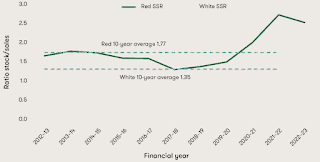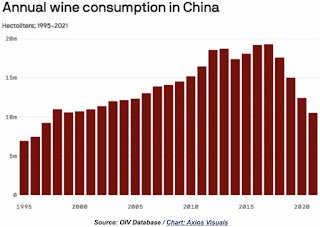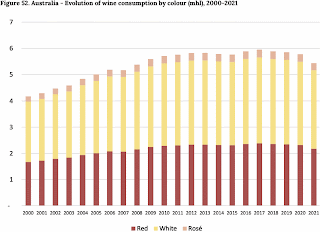The main issue in this week’s post is that the Australian wine industry is repeatedly presented in the media as currently being in a dire position. This situation is, in many ways, real; but the entire world’s wine industry has a somewhat similar problem, so there is not much that is actually unique about Australia. Furthermore, the Australian position is often attributed particularly to a trade spat with China (How Chinese tariffs soured Australia’s wine industry); and it is true that this spat exists, but resolving it may not be the panacea that the Australians seem to be expecting.
The essential problem is an over-supply of wine from within Australia itself. This is shown in the above infographic, from the Australian wine: Production, Sales and Inventory Report (by Wine Australia). Australian wine production is predicated upon exporting a large proportion of the product — as shown in the graphs at the very bottom of this post, consumption plateaued in 2010 but production did not. *
This origins of this situation have been discussed by several people. For example, according to Pia Piggott, an Associate Analyst at Rabobank, there are three factors behind this (Australia’s wine swimming pool):
- The 218% tariff imposed on Australian wine by China in 2021, widely seen as retaliation for Australian criticisms (a government minister suggested that China should be formally investigated about the origin of the SARS-CoV2 virus). Until then, China had been one of Australia’s most significant export markets, with sales reaching A$1.2 billion in the year to January 2020.
- The logistical bottlenecks caused by the Covid-19 pandemic. As shipping prices increased four- and then five-fold, ships began to bypass Australia in favour of shorter, higher-value routes. Many Australian wineries could not fulfill export orders, and lost their customers, leaving the Australians with too much wine.
- Australia has recently had record production. For example, the 2021 vintage was the largest vintage on record — a 36% year-on-year increase.
So, the current situation has been developing for quite some time. Nevertheless, the Australian wine industry does urgently need to deal with how to get rid of its wine lake. The obvious way is exports. Sadly, this is precisely what is not working, as shown in the next infographic, from the Wine Australia Export Report (see: Export results reflect challenging global trends). Two countries dominate the picture. The United Kingdom takes 36% of the total export volume and 19% of total export value, while the USA takes 22% of volume and 19% of value; and both of these figures are currently down considerably. ** All of the lower price points have decreased in export sales, although >$10 has increased (ie. Australian wine exports are moving up-market, by default!).
Needless to say, the Australian grape farmers are unhappy with the situation. For example, the farmers have argued that they are being paid below the cost of production for their grapes, and in some cases they have chosen to dump their grapes or let them rot on the vines, rather than be paid below cost prices for harvesting them (Riverland wine grape growers drive tractors through Renmark in protest against low prices). Their key demands of the government include making wine grape prices more sustainable, and improving support from the industry and government for growers. To this end, the Riverland grape growers call for moratorium on vine plantings to ease red wine oversupply crisis; and the government has just now appointed a task force (Wine taskforce to spotlight glut as industry reaches crisis point).
So, it seems that the Australian wine industry is set to shrink, considerably. The most recent report from Australia’s Agricultural and Resource Economics Bureau (ABARES) predicts that, by the 2027—28 harvest, Australian wine-grape production will have fallen to 1.2 million tonnes, down from a peak of over 2 million in 2021 (Forecasting wine: current storm clouds unlikely to budge).
However, the issue seems to me to be that Australia’s situation is simply part of a general downturn in the wine industry, globally. For example, the number of regular wine drinkers in Australia is falling overall, and the under-34 segment has shown the sharpest decrease, which is part of a global trend (Wine leaves a bad taste for younger drinkers). Similar problems have recently been discussed for France, the modern “home” of the wine industry (France no longer defines global wine culture. Can it adapt?), and their farmer reactions have also been similar (‘Emergency’ €80m promised to French winegrowers amid farmer protests). The USA is no better off (More bad news: Sipsource report pulls no punches), and neither is the UK (UK wine sales decreased by 10 million bottles in the build-up to Christmas). Indeed, the US growers have gone one better than the Australians (Growers scrap vineyards as market dims).
Over-supply is therefore actually a global problem. This overall topic has been discussed elsewhere, so I will not repeat it here:
- Wine, globalization, and the end of history
- Why are so many wine regions dealing with oversupply?
- Can the wine industry’s crisis be stopped?
The bottom line here is that the anticipated return of the Chinese market as a destination for Australian wine (China wine tariff result by end of March) may not be the hoped-for panacea (Australian wine makers bet on expected China reopening with big shipments). After all, there has been a downward trend in Chinese wine consumption since 2018, as shown in the next graph (Chinese wine drinkers — unlikely to solve Australia's export woes); and wine imports have followed suit (Chinese wine market falls off cliff). A return of the China export market will therefore presumably not be a great boon. ***
So, to summarize, we can safely say that the Australian wine industry is facing a crisis (It’s all change for Australian wine in 2024):
- Revenues in the sector, which directly employs more than 18,000 people, have declined at a combined annal rate of -6.3% over the past five years, and stood at an estimated AU$6.3 billion at the end of last year.
- The AU$1.3 billion-per-year China export market collapsed when Beijing slapped tariffs on Australian wine in late 2020; and while China is expected to soon remove — or at least modify — those impositions, the industry faces a much-changed global condition.
- Globally, consumers have moved away from commodity bottles in favour of premium priced labels, and Wine Australia calculates that the industry has surplus stocks of more than 2 million wine bottles.
- At the same time, home market demand has been declining for the past 4 years in Australia, and is forecast to reach 445 million litres this year, compared with a 10-year average of 480 million litres. Prices have increased only marginally since 2019.
* Australian wine consumption plateaued in 2010, and has even dropped recently; on the other hand, production has varied dramatically year by year, at about twice the level of consumption (the graphs here are from: Focus OIV 2023: Evolution of world wine production and consumption by colour).
** It is worth noting here that Australian wine exports to the USA have been declining since 2007, as shown by this linked AAWE graph.
*** So, the Spaniards should not be so keen, either (Can Spanish wine producers spread their wings in China?).








No comments:
Post a Comment